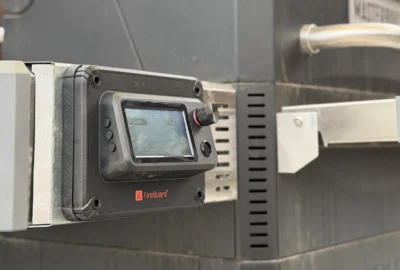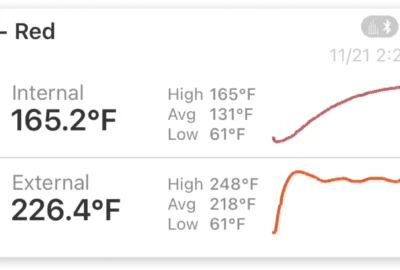Science, Tech, Using your FireBoard
Are Wireless Probe Ambient Sensors Accurate?
Recently, debates have arisen over the value of wired versus wireless probes, single versus multi-sensor designs, and the merit of having an ambient temperature sensor inside a wireless probe. Because the FireBoard Pulse is a wireless temperature probe with a single internal sensor as well as an external ambient sensor, we have some stake in the conversation and want to address the room full of elephants. We’ve conducted many experiments to back up the information in this post and will be focusing on one in particular to illustrate our points.
Uniform ambient temperature is a myth
Let’s start by defining what we’re talking about when we say “ambient” temperature. The ambient temperature, by popular definition, is supposed to reflect the overall internal temperature of the grill or smoker, rather than whatever is cooking inside it.
The first thing to know is that a grill’s ambient temperature is far from even throughout. Multiple factors influence temperature distribution, creating a complex thermal environment where temperature can vary significantly from one spot to another. Heat source location and intensity, the grill’s design and materials, airflow patterns within the grill, the position of the lid, and even external weather conditions all work together to make sure a single ambient temperature is conditional at best.
So, let’s take a look at the variables we’re working with:

In this test, we have a brisket skewered by four Pulse probes as well as three wired temperature probes to measure ambient temperatures in different areas of the grill interior. Let’s update our chart to view only those wired probes’ ambient reads:

We can see that while these probes roughly follow the same curve throughout, there is a notable degree of difference between them, particularly in the first five or six hours of the cook.
Now let’s take a look at the Pulse ambient readings:

It’s clear to see that the wireless probe ambient sensors stayed within a similar range of the wired temps. Note that the probes were pulled around 8AM, where the temperature dropoff is visible.
Now, let’s combine these charts:

We can see that the most significant difference in ambient temperature readings between the wired probes vs. the Pulses takes place in the first two hours of the cook. This can be attributed to the wired probes being physically clamped to the grill grate, thus heating them more quickly through conduction. The wireless probes took more time to catch up because they were only in direct contact with the meat. Once they reached the three-hour mark, every ambient reading was within a comparable range of each other, with Pulse readings tending to skew a few degrees lower on average due to the above-mentioned factor as well as the heat sink from the meat as it absorbed heat.
Now, that’s an important point if you’re trying to use a wireless probe to gauge the ambient temperature of a grill, right? There are cases where you won’t want to throw any meat on the grill before the grill has reached a proper temperature, but how do you know if it’s at the proper temperature if your ambient probe is currently sitting in the meat waiting outside the grill? There’s no single solution here – not because of any probe capabilities or features, but because of the ways things just…are.
You want your wireless probe inserted into the meat. You put the meat on the grill when the grill is ready. You don’t know when the grill is ready until you see its ambient temperature hit a certain level. You don’t know the ambient temperature because your ambient sensor is in the meat, which can’t go onto the grill until…you get the idea.
So when does it make sense to use the ambient read on a wireless probe?
That’s ultimately up to you – the one doing the grilling. You may have a use case that isn’t obvious but feel frustrated that no other wireless probe offers that feature. The Pulse is there to say “Hey, I have this feature. Here’s what you should expect to see, so keep that in mind, and let’s go kick some @#$!”
Now, let’s take a look at the readings that matter most: the actual internal temperature of the brisket, measured by the Pulses’ internal sensors:

As you can see, placement matters! Each Pulse steadily recorded the temperature of each section of the brisket, but that temperature was unevenly distributed, compounded by the varying insertion depth of each probe. Despite all of that variability, we can clearly see when the brisket hit the ideal temperature as each reading converged at about 8AM.
So what does all of this mean?
As much as we might like it to be, exact ambient temperatures are highly conditional. If someone were to ask you “What’s your grill’s ambient temperature?” an appropriate follow-up would be asking them, “Where?”
The interior environment of an active grill is filled with hot and cold spots, which are influenced by the size, density, and temperature of whatever is placed inside it, which also influences any devices inside that are trying to accurately tell us what’s going on in there. Yet, considering all that chaos, we actually have a pretty good read on the situation.
Ultimately, an ambient temperature read is one data point among many to be taken into consideration as you try and reach a specific internal temperature for the food itself – the grill’s ambient temperature is just the vehicle that gets you there.
(Now, this could potentially change if, say, someone were to create a hardware solution for evenly distributing the airflow throughout, say, a kettle grill. Something like that would certainly help you achieve a more consistent ambient temperature. If that were to exist, of course. Hypothetically.)

Single Internal Sensor vs. Multiple Sensors
Some wireless probe systems boast multiple internal sensors, ranging from three to six. While this might seem impressive, more sensors don’t necessarily translate to better cooking results, just as more wheels on a truck don’t make it go faster (though, in this analogy, four wheels would be a smart minimum). A single-sensor design can often be superior for several reasons.
Firstly, a single, high-quality sensor can often provide more reliable readings than multiple sensors, focusing on precision and accuracy rather than the quantity of data points. The simplicity of a single sensor also aids in usability, preventing confusion that can arise from multiple, potentially conflicting readings.
With fewer sensors, there’s less potential for electronic interference or calibration discrepancies between multiple sensors. The consistency of getting readings from a single point can be more reliable for tracking temperature changes over time, allowing for a better understanding of your grill’s behavior.
This leads to the most important point underlying the entire conversation: relying on a single, accurate sensor enables enthusiasts to develop a better understanding of their grill’s heat dynamics, rather than depending solely on the technology. This approach encourages grill mastery and a more intuitive cooking experience.
Remember, great grilling comes from understanding your equipment and developing your skills, not just from having more data points. Some of the most decorated grill masters in Brazil use their thumbs to check temperatures. How many sensors do they have in those thumbs?!
At the end of the day, grilling is a profession for some and a hobby for many. Your mileage may vary depending on your experience and level of interest. There’s absolutely nothing wrong with wanting to measure 4-5 internal temperatures at once with one probe – just know that the quality of your results won’t be 4-5 times better than if you had just one.
Our official stance is that you should just grill how you want to grill and find the best solution to fit what you want to do. The Pulse was made to cater broadly to grillers, smokers, and home cooks of all experience levels by providing as many options as possible. If you’ve been looking for a wireless probe with an ambient sensor, you’re in luck! If you think the idea is ludicrous, that’s okay – there are plenty of great options out there!
Best Practices for Using Wireless Ambient Probes
Let’s wrap up with some general best practices.
- Place the probe near your food, but not touching any surfaces, to get an accurate reading of the air temperature surrounding your dish.
- Use the probe to learn about temperature zones in your grill over time, building a mental map of your grill’s unique thermal characteristics.
- Focus on monitoring trends over time, rather than fixating on absolute numbers, as this will give you a better understanding of how your grill behaves during a cook.
- Most importantly, trust in the quality of the sensor rather than the quantity of readings, using the data as a tool to enhance your grilling intuition rather than replace it.









Leave a reply